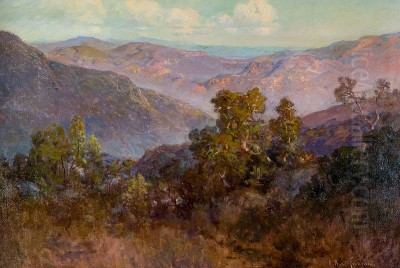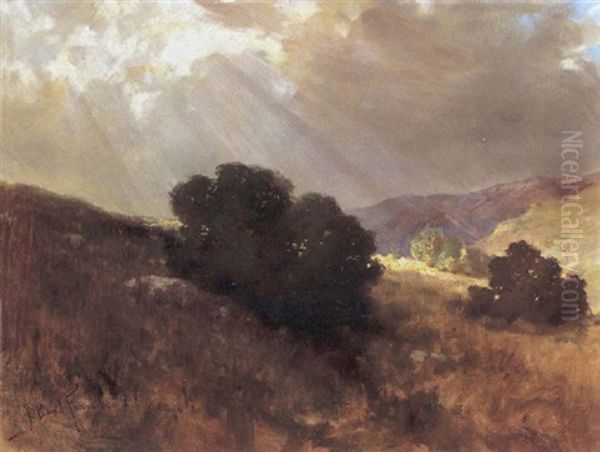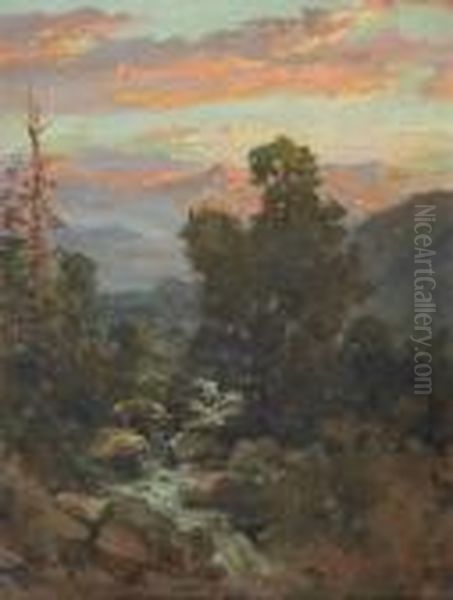
John Bond Francisco stands as a significant, albeit sometimes overlooked, figure in the annals of American art, particularly within the vibrant Californian Impressionist movement of the late 19th and early 20th centuries. A man of diverse talents, Francisco was not only a gifted painter, celebrated for his evocative landscapes, but also an accomplished violinist and conductor who played a pivotal role in the burgeoning cultural scene of Los Angeles. His life and work offer a fascinating glimpse into a period of dynamic artistic development on the American West Coast, where the unique light and landscape inspired a generation of artists.
Early Life and Artistic Awakening
Born in Cincinnati, Ohio, on December 14, 1863, John Bond Francisco's early life was steeped in an environment that, while not yet a major art center like New York or Boston, was nonetheless a city with a growing appreciation for culture. Cincinnati, known as the "Queen City of the West," had a burgeoning arts scene, and it is likely that young Francisco was exposed to various artistic and musical influences from an early age. His innate talents for both visual art and music became apparent, setting him on a path that would see him pursue both disciplines with considerable passion and skill throughout his life.
The decision to formally train in these fields led him, like many aspiring American artists and musicians of his era, to Europe. The continent, particularly Paris for art and Germany for music, was considered the crucible for serious artistic education. This transatlantic journey was a rite of passage, promising exposure to masterworks, rigorous training, and the stimulating company of fellow artists from around the world.
European Sojourn: Forging an Artist and Musician

Francisco's European studies were comprehensive. For his painterly development, he immersed himself in the Parisian art world. He enrolled at the prestigious Académie Julian, a private art school renowned for attracting international students, including many Americans. The Académie Julian offered a more liberal alternative to the highly traditional École des Beaux-Arts and was a hotbed for emerging talents. Here, he would have studied under noted academic painters, honing his skills in drawing and composition. He also attended the Académie Colarossi, another significant independent art school in Paris that provided a similar environment of rigorous training and artistic exchange. These institutions were critical in shaping his technical foundation.
Contemporaneously, Francisco pursued his musical education with equal dedication. He traveled to Germany, studying music in the esteemed conservatories of Berlin and Munich. These cities were epicenters of classical music, offering unparalleled instruction in violin performance and orchestral conducting. This dual immersion in the highest echelons of European art and music provided him with a rich, multifaceted education that would profoundly influence his later career. His time in Europe exposed him to the prevailing artistic currents, including the lingering influence of the Barbizon School and the revolutionary impact of Impressionism.
The Barbizon Influence
During his formative years in Europe, Francisco undoubtedly absorbed the tenets of various artistic movements. One significant influence that can be discerned in his work is that of the Barbizon School. This group of French painters, active from roughly the 1830s to the 1870s, rejected the idealized landscapes of academic tradition. Instead, artists like Jean-Baptiste-Camille Corot, Jean-François Millet, and Théodore Rousseau advocated for a more naturalistic and direct depiction of the countryside, often painting en plein air (outdoors) to capture the fleeting effects of light and atmosphere.
The Barbizon painters emphasized tonal harmony, subtle color palettes, and an emotional connection to the landscape. Their focus on rural scenes, peasant life, and the quiet dignity of nature resonated with many artists seeking an alternative to academic historicism. Francisco's later landscape work, particularly his sensitive rendering of light and his ability to evoke mood, shows an affinity with Barbizon principles. This emphasis on capturing the essence and atmosphere of a place, rather than a purely topographical representation, would become a hallmark of his style.
Embracing Impressionism
While the Barbizon School provided a foundation in naturalistic landscape painting, the most transformative movement sweeping through Paris during Francisco's time there was Impressionism. Pioneered by artists such as Claude Monet, Camille Pissarro, Pierre-Auguste Renoir, and Edgar Degas, Impressionism revolutionized the way artists perceived and depicted the world. It emphasized capturing the fleeting moment, the subjective experience of light and color, and often featured broken brushwork and a vibrant palette.

Francisco, like many of his American contemporaries who studied in France, was profoundly influenced by Impressionism. He adopted its focus on light and color, its looser brushwork, and its commitment to plein-air painting. However, American Impressionism often retained a greater sense of structure and form compared to its French counterpart, and Francisco's work reflects this tendency. He skillfully blended the atmospheric qualities of Impressionism with the tonal subtleties and compositional strength rooted in his academic and Barbizon-influenced training. This synthesis would prove particularly well-suited to capturing the unique environmental conditions of California.
Return to America and the Lure of California
Upon completing his European studies, John Bond Francisco returned to the United States. In 1887, he made a pivotal decision that would define his career: he settled in Los Angeles, California. At this time, Los Angeles was a rapidly growing city, transitioning from a small pueblo to a burgeoning metropolis. The region's stunning natural beauty, diverse landscapes, and, most importantly, its brilliant, clear light were beginning to attract artists from across the country.
California offered a new frontier for American painters. The dramatic coastline, rolling hills, majestic mountains, and arid deserts presented a visual vocabulary distinct from the European or Eastern American landscapes. Francisco was among the vanguard of artists who recognized the artistic potential of this environment. He was drawn to the atmospheric effects, the vibrant colors of wildflowers, the ruggedness of the terrain, and the unique quality of the Pacific light, which could be both intensely bright and softly diffused.
A Dual Career: Art and Music in Los Angeles
In Los Angeles, Francisco ingeniously combined his two passions. He quickly established himself not only as a prominent painter but also as a key figure in the city's musical life. In a testament to his musical prowess and leadership, he played a crucial role in founding the Los Angeles Symphony Orchestra in 1897 and served as its first concertmaster and conductor. This was a significant cultural milestone for the developing city, and Francisco's involvement underscored his commitment to fostering artistic excellence in his adopted home.
His home and studio, located at 1401 Alger Street in the Edendale district (near what is now Echo Park), became a vibrant cultural hub. It was a gathering place for fellow artists, musicians, writers, and intellectuals, fostering a lively exchange of ideas and contributing to the city's burgeoning artistic community. Here, he would perform, teach, and entertain, creating an environment where art and music coexisted and enriched each other. This dual identity as a respected painter and musician made him a unique and influential personality in early Los Angeles.
Capturing the Californian Light: Francisco's Landscape Art
John Bond Francisco's artistic reputation rests primarily on his landscape paintings. He became one of Southern California's most important early Impressionist painters, specializing in capturing the region's diverse scenery. His canvases often depicted the San Gabriel Mountains, the rolling hills covered in poppies and lupines, the rugged coastline, and the arid beauty of the desert. He was particularly adept at rendering the atmospheric effects of the Californian light, from the hazy mornings to the brilliant sunshine of midday and the warm glow of sunset.
His style is characterized by a rich, often tonal, Impressionism. While he employed broken brushwork and a concern for the optical effects of light, his compositions retained a strong sense of structure and solidity. He had a remarkable ability to convey the grandeur and scale of the Californian landscape, as well as its more intimate moods. His palette, influenced by the Barbizon School's emphasis on natural color, was often subtle yet capable of capturing the vibrant hues of California's flora and skies.
One of his notable works, often cited, is "Scrub Oak," which exemplifies his skill in depicting the local landscape, in this case, the San Gabriel Mountains, with a keen eye for atmospheric conditions, such as the threatening sky before a storm. Other subjects that frequently appear in his oeuvre include eucalyptus groves, poppy fields stretching across hillsides, and panoramic vistas. For instance, paintings titled along the lines of "California Poppies," "The Old Oak," "Eucalyptus Grove," or "Sunset in the Sierras" (though specific titles vary and records can be sparse) reflect his deep engagement with the characteristic elements of the California landscape.
He also ventured further afield, painting in Northern Arizona, where he was captivated by the majestic Grand Canyon. He is known to have produced at least one significant painting of the Grand Canyon for the Santa Fe Railway, which was a major patron of artists depicting the American Southwest, using their work to promote tourism along its routes. Artists like Thomas Moran had earlier established a tradition of Grand Canyon painting, and Francisco contributed to this genre with his own Impressionistic interpretation.
Plein Air Painting and Artistic Expeditions
A crucial aspect of Francisco's artistic practice, and that of many California Impressionists, was en plein air painting. This commitment to working directly from nature allowed him to capture the immediate and transient effects of light and atmosphere that were so central to the Impressionist aesthetic. He would venture into the countryside, setting up his easel in the Arroyo Seco, the foothills of the San Gabriels, or the coastal regions, to record his observations firsthand.
He often undertook painting expeditions with fellow artists. One of his frequent companions was Elmer Wachtel, another prominent California Impressionist landscape painter. Together, they would explore and paint the diverse terrains of Southern California. These collaborations and shared experiences were vital for the development of the regional art scene, fostering a sense of camaraderie and mutual influence among artists. Elmer Wachtel, along with his wife Marion Kavanagh Wachtel (herself a talented watercolorist and painter), became key figures in the California Impressionist movement, and their association with Francisco highlights the close-knit nature of the artistic community.
Key Exhibitions and Recognition
John Bond Francisco's work was exhibited regularly during his lifetime and received critical acclaim. A significant moment of recognition for California Impressionism, and for Francisco, was the Panama-Pacific International Exposition held in San Francisco in 1915. This major world's fair featured an extensive art exhibition that prominently showcased the work of California artists, effectively announcing the arrival of a distinct and accomplished regional school of Impressionism. Francisco's participation in such an event would have solidified his reputation on a broader stage. His works were also likely shown in various local and regional exhibitions, including those organized by the California Art Club, an influential organization founded in 1909 that played a key role in promoting Impressionism in the state.
His paintings were sought after by collectors who appreciated his ability to capture the unique beauty of California. The dramatic light and shadow effects in his depictions of mountains and deserts were particularly popular. While specific exhibition records from that era can be challenging to compile comprehensively, his consistent output and respected position within the art community suggest a steady presence in the exhibition circuit of the time. The mention of an exhibition titled "Fo Tejon Ranch" in California Art Club literature further indicates his active participation in the art world.
Contemporaries and the Californian Art Scene
John Bond Francisco was part of a remarkable cohort of artists who shaped the California Impressionist movement. This group, active primarily from the 1890s through the 1930s, developed a style characterized by its bright palette, bold brushwork, and focus on the unique light and landscapes of California. Besides Elmer and Marion Kavanagh Wachtel, other key figures in this movement included:
William Wendt: Often called the "dean of Southern California landscape painters," Wendt was known for his powerful, structured depictions of the California landscape, often imbued with a spiritual quality.
Guy Rose: Having spent considerable time in Giverny and absorbed French Impressionism directly, Rose brought a refined, classic Impressionist style to his California scenes.
Granville Redmond: A deaf artist known for his vibrant depictions of poppy and lupine fields, as well as more moody, tonalist nocturnes. He was also a friend of Charlie Chaplin and appeared in several of his films.
Franz Bischoff: Famous for his paintings of roses and, later, for his bold, colorful landscapes of the Sierra Nevada and Zion National Park.
Alson S. Clark: Another artist with strong ties to French Impressionism, Clark painted diverse subjects, including Panama Canal scenes and California landscapes.
Benjamin Chambers Brown: Known for his Impressionistic landscapes of Pasadena and the Sierra Nevada, and a founding member of the California Art Club.
Edgar Payne: Celebrated for his dynamic, monumental paintings of the Sierra Nevada mountains and the Southwest, as well as European scenes and seascapes.
Maurice Braun: An important San Diego-based Impressionist, known for his depictions of the Southern California landscape with a mystical, Theosophical undertone.
Joseph Kleitsch: A Hungarian-born artist who settled in Laguna Beach, known for his vibrant, high-key Impressionist street scenes and landscapes.
These artists, along with Francisco, formed a vibrant community, often exhibiting together, sharing techniques, and collectively defining a distinctly Californian approach to Impressionism. They captured the optimism and natural splendor of a rapidly developing state, leaving behind a rich visual legacy.
Legacy and Enduring Influence
John Bond Francisco passed away in Los Angeles on January 1, 1931. His death marked the end of a multifaceted career that had significantly enriched the cultural life of Southern California. As a painter, he was a pioneer of California Impressionism, one of the first artists to truly capture the unique light and atmosphere of the region with an Impressionist sensibility. His works are valued for their artistic merit, their historical importance in documenting the California landscape before extensive development, and their role in establishing a regional artistic identity.
His contributions as a musician and conductor, particularly in founding and leading the Los Angeles Symphony Orchestra, were equally vital. He helped lay the groundwork for Los Angeles to become the major center for classical music that it is today. His ability to excel in both art and music speaks to his remarkable talent and dedication.
Today, John Bond Francisco's paintings are held in private collections and public institutions, including museums specializing in California art. They continue to be appreciated for their beauty, their technical skill, and their evocative portrayal of a bygone era of California's natural splendor. He is remembered as a key figure among the early Los Angeles artists who saw the immense artistic potential of the West Coast and dedicated their talents to interpreting its unique character.
Conclusion
John Bond Francisco's life was a harmonious blend of visual artistry and musical expression. He navigated the transatlantic currents of artistic education, absorbing European traditions and innovations, and then applied them to the distinct environment of California. As an Impressionist painter, he masterfully captured the light, color, and mood of the Californian landscape, contributing significantly to one of America's most beloved regional art movements. As a musician, he was a foundational figure in Los Angeles's classical music scene. His legacy endures through his captivating paintings and his pioneering efforts in fostering a rich cultural environment in his adopted city, securing his place as a distinguished artist and a cultural catalyst in the history of California.